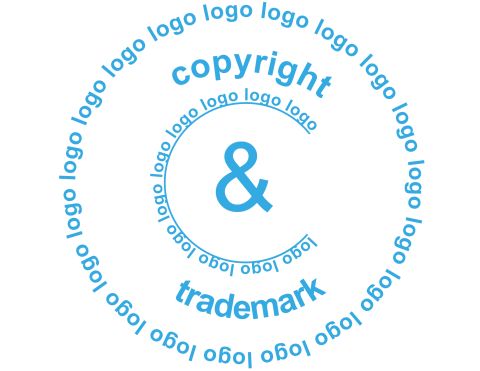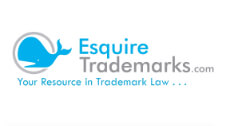Copyright Law Protects Graphics and Logos – Trademark & Copyright a Logo
Graphics and logos are protectable under both Trademark and Copyright Law. Many brand owners are not aware of copyrights that exist in a graphic or logo. Often, owners believe trademark protection is enough, and forgo registering copyright in a logo. You can get additional – and better protection using copyright law. This is why you should do both: Trademark and Copyright a Logo.

Why Copyright a Logo?
Trademark Law is different and provides different protections. You should register copyright in a logo to get additional protections and damages under the copyright laws. Copyright automatically exists in the logo when it is created, but copyrights are not perfected until the logo is registered with the Copyright Office.
A copyright registration in a logo provides the following benefits:
Copyrighted logos are automatically protected and do not require proof of use like trademark protection (aka protection of logos before they are trademarked)
Internet Service Providers are faster to remove copyright-based infringement than trademark-based infringement.
US Copyright Registrations are honored Internationally in any country who is a member of the Berne Convention.
You can sue for copyright infringement even when the logo is used on unrelated goods or services.
Statutory damages are available for copyright infringement of a logo that is registered with the copyright office
Attorney’s fees are awarded for copyright infringement– but are rarely awarded for trademark infringement
1.You Can Secure Copyright for a Logo Before Selling the Goods or Services – While the Brand Is in Development.
In order to secure trademark rights in a graphic or logo, the artwork must be used in commerce on the goods or services. Use in commerce means that goods must be sold with the mark on the product or label. When the mark is for services, “use in commerce” requires the logo to be displayed in connection with the services. It’s not a simple task to bring branded products and services to market. Yet, brand owners need to protect their identity while the business is in start up. Copyright a logo to protect the artwork while you are in the development stages – before trademark rights can be perfected.
Trademark Law has the Intent-to-Use registration process, which allows businesses to apply for trademarks before they are being used. A trademark application will not register, however, until the owner can prove use in commerce. This can take several months, up to 3 years. Trademark rights will remain unprotected for this time period, and a brand owner will be unable to sue under trademark law. A copyright owner can file suit once a logo copyright application is filed in many jurisdictions. Copyright a logo to secure a right to sue for infringement – even while the business is in start up phase.
2. Internet Service Providers are faster to remove copyright-based infringement.
Internet service providers such as YouTube Facebook, Twitter, eBay, Amazon, and others are not required to enforce trademark rights. In other words, Internet Service Providers are not held liable for damages if fake users or dishonest competitors are using your trademarks on the Internet service. For example, an Amazon user may be a fake user that is selling fake goods under your trademark or a confusing similar trademark.
Copyright Law, under the DMCA, in certain circumstances makes Internet service providers liable for copyright related matters of its users. Under current Federal Trademark law, there is no similar or equivalent law to the DMCA. That is, there is no law which enforces rights against Internet services providers for trademark infringement committed by users. As a consequence, an Internet service provider usually only acts when there is an instance of clear copyright infringement. Such action is usually done by the Internet service provider in order to avoid liability under the DMCA or under Federal Copyright Law in general. Learn more about the Digital Millennium Copyright Act (DMCA) here.
3. Copyright Provides International Protection for Logos
Logos and graphic designs are protectable under copyright law. Thanks to several treaties, copyright protections are international in scope. Most countries offer protection to foreign copyright works. There are two principal international copyright conventions; the Berne Convention for the Protection of Literary and Artistic Works (Berne Convention), and the Universal Copyright Convention (UCC).
The majority of the world’s most significant countries are included in the Berne Union. For a complete list of the countries that are part of the Berne Convention and other international treaties, (i.e., the Universal Copyright Convention) visit The Copyright Office.
The main benefit of the Berne Convention is that it prohibits foreign countries from any attempts of imposing formalities on copyright protection. Therefore, use of the copyright is only subject to formality in the country of origin.
4. You Can Sue for Copyright Even When the Logo Is Used on Unrelated Goods/Services
Trademark law only protects your logo when its use by another creates marketplace confusion as to source, sponsorship, or affiliation. There are some exceptions, but generally, trademark law protects from confusion as to the source of the goods/services.
Copyright law protects the unauthorized copying of your logo. Simply copying the artwork can give rise to a claim for copyright infringement. Therefore, you can sue anyone for using your logo without permission (except in instances of fair use). Practically speaking, with a copyright registration, you can enforce the copyrights in your logo and incidentally protect your brand identity.
5. Registered Copyright Owners of Logos Can Elect Statutory Damages
Under both copyright and trademark law, a defendant must pay damages for any harm done to the plaintiff’s business. In addition, the defendant must turn over its profits from the infringing activity to the plaintiff. This seems like a good thing, but damages and profits are difficult, costly, and time consuming to prove. If the logo is a registered copyright, the owner can elect statutory damages, and bypass the (often difficult) process of establishing damages and lost profits.
What are statutory damages for infringement of registered copyright in a Logo?
Statutory damages are damage amounts that are set by the copyright laws. Statutory copyright damages may range between $200 and $150,000 per infringed upon work, depending on the circumstances of the case. The $200 damage amount is for innocent infringement, where the “infringer was not aware and had no reason to believe that his or her acts constituted an infringement of copyright”. 17 U.S.C. §504(c).
Trademark law is different. Statutory damages in trademark law may be sought by registered trademark owners only in cases involving use of a counterfeit trademark or involving cybersquatting. 15 U.S.C. § 1117. Copyright a logo to gain the right to elect statutory damages for infringement – something typically not available in trademark law.
6. The Copyright Act Provides for Attorney’s Fees for Infringement of a Registered Logo
The Copyright Act allows for Attorney’s Fees for prevailing parties. 17 U.S.C. §§ 412, 505. The Trademark Act (on the other hand) allows for Attorney’s Fees only in “exceptional cases.” 15 U.S.C. § 1117. The burden of proving an exceptional case is on the plaintiff, and requires a significant amount of evidence of willfulness and/or “bad faith” conduct. Further, courts rarely find trademark infringement cases to be exceptional. As such, where a logo is covered by copyright registration, a prevailing plaintiff may obtain attorney’s fees without the added burden of proving an “exceptional case”.
Copyright a logo because a prevailing plaintiff may obtain attorney’s fees against a copyright infringer without the added burden of proving an “exceptional case”.
Consult a Licensed Attorney:
Charles Riddle at EsquireTrademarks.com has 20 years experience practicing trademark, copyright, and intellectual property law. We can answer your legal questions on the spot. We use our experience to guide you through the trademarking process and avoid common pitfalls.
